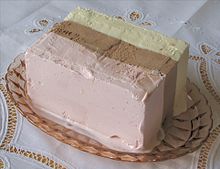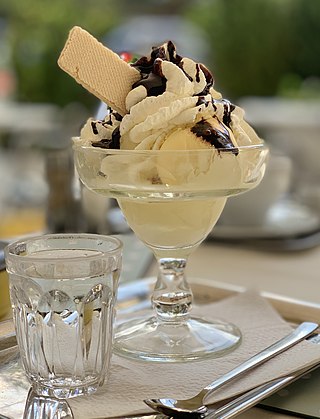
Ice cream is a frozen dessert typically made from milk or cream that has been flavoured with a sweetener, either sugar or an alternative, and a spice, such as cocoa or vanilla, or with fruit, such as strawberries or peaches. Food colouring is sometimes added in addition to stabilizers. The mixture is cooled below the freezing point of water and stirred to incorporate air spaces and prevent detectable ice crystals from forming. It can also be made by whisking a flavoured cream base and liquid nitrogen together. The result is a smooth, semi-solid foam that is solid at very low temperatures. It becomes more malleable as its temperature increases.

Trifle is a layered dessert of English origin. The usual ingredients are a thin layer of sponge fingers or sponge cake soaked in sherry or another fortified wine, a fruit element, custard and whipped cream layered in that order in a glass dish. The contents of a trifle are highly variable and many varieties exist, some forgoing fruit entirely and instead using other ingredients, such as chocolate, coffee or vanilla. The fruit and sponge layers may be suspended in fruit-flavoured jelly, and these ingredients are usually arranged to produce three or four layers. The assembled dessert can be topped with whipped cream or, more traditionally, syllabub.
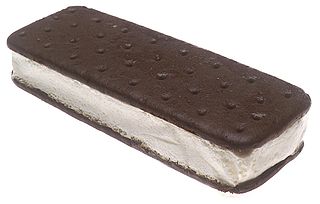
An ice cream sandwich is a frozen dessert consisting of ice cream between two biscuits, wafers, cookies, or baked goods. The ingredients are different around the world, with Ireland using wafers and the United States commonly using cookies.

Kulfi is a frozen dairy dessert from the Indian subcontinent. It is often described as "traditional Indian ice cream". Kulfi originated in 16th-century Delhi during the Mughal era. It is part of the national cuisines of India, Pakistan, and Trinidad and Tobago. It is also popular in Bangladesh, Myanmar, Nepal, Sri Lanka, and the Middle East.

A mille-feuille, also known by the names Napoleon in North America, vanilla slice in the United Kingdom, and custard slice, is a French dessert made of puff pastry layered with pastry cream. Its modern form was influenced by improvements made by Marie-Antoine Carême.

Spumone is a molded gelato made with layers of different colors and flavors, usually containing candied fruits and nuts.

A Swiss roll, jelly roll, roll cake, cream roll, roulade or Swiss log is a type of rolled sponge cake filled with whipped cream, jam, icing, or any type of filling. The origins of the term are unclear; in spite of the name "Swiss roll", the cake is believed to have originated elsewhere in Central Europe, possibly Austria or Slovenia. It appears to have been invented in the nineteenth century, along with Battenberg cake, doughnuts, and Victoria sponge. In the U.S., commercial snack-sized versions of the cake are sold with the brand names Ho Hos, Yodels, Swiss Cake Rolls, and others. A type of roll cake called Yule log is traditionally served at Christmas.
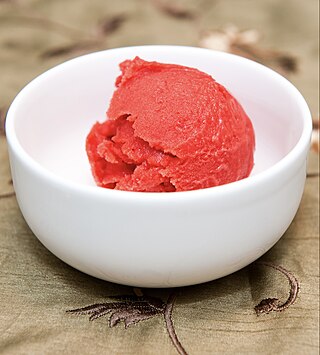
Sorbet is a frozen dessert made using ice combined with fruit juice, fruit purée, or other ingredients, such as wine, liqueur, or honey. Generally, sorbets do not contain dairy products.

Chocolate ice cream is ice cream with natural or artificial chocolate flavoring. One of the oldest flavors of ice creams, it is also one of the world's most popular. While most often sold alone, it is also a base for many other flavors.
Parlour is a brand of frozen dessert currently produced by Nestlé. Parlour comes in many different flavours and is available mainly in Canada. Originally produced by Sealtest Ice Cream Parlor in the United States as an ice cream, it no longer meets the legal definition of ice cream due to a change in the recipe; the high content of palm oils. Parlour now competes with bigger brands of ice cream such as: Chapman's, Breyers and others.

Bread and butter pudding is a traditional bread pudding in British cuisine. Slices of buttered bread scattered with raisins are layered in an oven dish, covered with an egg custard mixture seasoned with nutmeg, vanilla, or other spices, then baked.

Vanilla is frequently used to flavor ice cream, especially in North America, Asia, and Europe. Vanilla ice cream, like other flavors of ice cream, was originally created by cooling a mixture made of cream, sugar, and vanilla above a container of ice and salt. The type of vanilla used to flavor ice cream varies by location. In North America and Europe consumers are interested in a more prominent, smoky flavor, while in Ireland, a more anise-like flavor is desired. To create the smooth consistency of ice cream, the mixture has to be stirred occasionally and then returned to the container of ice and salt to continue the solidification process. According to Iced: 180 Very Cool Concoctions, many people often consider vanilla to be the "default" or "plain" flavor of ice cream.

Sponge cake is a light cake made with eggs, flour and sugar, sometimes leavened with baking powder. Some sponge cakes do not contain egg yolks, like angel food cake, but most of them do. Sponge cakes, leavened with beaten eggs, originated during the Renaissance, possibly in Spain. The sponge cake is thought to be one of the first non-yeasted cakes, and the earliest attested sponge cake recipe in English is found in a book by the English poet Gervase Markham, The English Huswife, Containing the Inward and Outward Virtues Which Ought to Be in a Complete Woman (1615). Still, the cake was much more like a cracker: thin and crispy. Sponge cakes became the cake recognised today when bakers started using beaten eggs as a rising agent in the mid-18th century. The Victorian creation of baking powder by English food manufacturer Alfred Bird in 1843 allowed the addition of butter to the traditional sponge recipe, resulting in the creation of the Victoria sponge. Cakes are available in many flavours and have many recipes as well. Sponge cakes have become snack cakes via the Twinkie.

Semolina pudding or semolina porridge is a porridge-type pudding made from semolina, which is cooked with milk, or a mixture of milk and water, or just water. It is often served with sugar, cocoa powder, cinnamon, raisins, fruit, or syrup. It is similar to grain based halva or halawa. A similar consistency to rice pudding can also be made by using more semolina and by baking, rather than boiling.
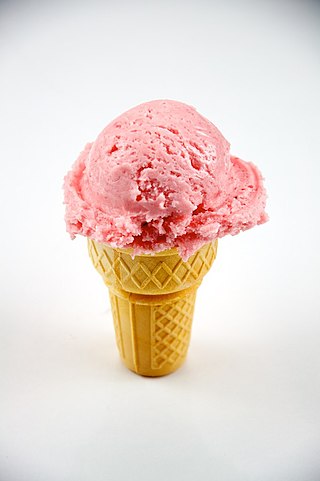
Strawberry ice cream is a flavor of ice cream made with strawberry or strawberry flavoring. It is made by blending in fresh strawberries or strawberry flavoring with the eggs, cream, vanilla, and sugar used to make ice cream. Most strawberry ice cream is colored pink or light red. Strawberry ice cream dates back at least to 1813, when it was served at the second inauguration of James Madison. Along with vanilla and chocolate ice cream, strawberry is one of the three flavors in Neapolitan ice cream. Variations of strawberry ice cream include strawberry cheesecake ice cream and strawberry ripple ice cream, which is vanilla ice cream with a ribbon of strawberry jam or syrup. Some ice cream sandwiches are prepared neapolitan-style, and include strawberry ice cream. According to a poll among American adults from July 13–18 of 2022, 43 percent of respondents stated that they enjoy strawberry ice cream while 6 percent stated that strawberry ice cream was their favorite flavor of ice cream. National Strawberry Ice Cream day is celebrated every year on January 15.

A sandwich cookie, also known as a sandwich biscuit, is a type of cookie made from two thin cookies or medium cookies with a filling between them. Many types of fillings are used, such as cream, ganache, buttercream, chocolate, cream cheese, jam, peanut butter, lemon curd, or ice cream.
